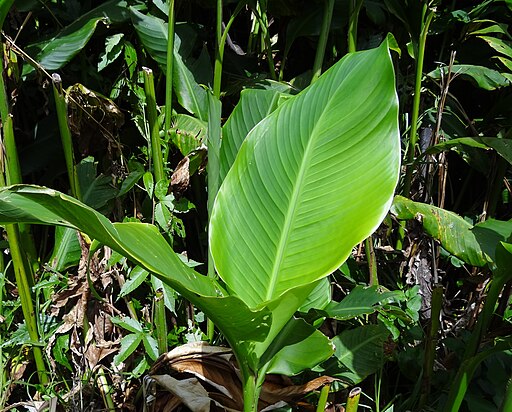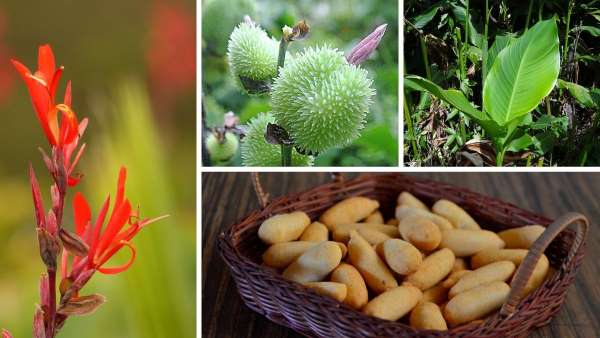
Origin, species, types, agronomic management, food and medicinal uses.
Discover all about the achira: a plant with surprising properties, multiple names, multiple uses — as food and medicine — resistant to pests, and which, unfortunately, is cultivated and consumed less and less.
✅ 26 common names of the achira
The achira plant (Canna indica) has at least 26 names, apart from achira — which is derived from the Quechua word acuy, meaning sneezing.
It is called achira and sago in Cundinamarca, Colombia (which is an improper name because it is confused with the sago palm, Maranta arundinacea, with long leaves and from whose trunk a type of starch similar to that of the achira is extracted). In other regions of Colombia they also call it chisgua or risgua.
In Venezuela it is known as bihao, bijao, capacho or maraca .
They call it conga or atzera in Loja, Ecuador .
Canna or biri are another common names used to refer to this plant in Brazil.
They call it Zulu or pericagua in Peru .
On some Caribbean islands and in the African Republic of Sierra Leone they call it cucuyús, juquián, Indian cane, beaded cane, cañancoro, crab flower, platanillo, chancle, caeté, red achira, yerba del rosario or arrowroot.
As if that were not enough, in Mexico they call it burdock, Papantla and acaxochitl.
These vernacular names are used interchangeably to name other species of the Canna genus, apart from C. indica: C. coccinea, C. edulis, C. generalis, and C. lutea, which it closely resembles. Or simply, it is a taxonomic duplication of the scientific name for the same species.
✅ Origin of Canna indica
The achira plant is native to America, probably from the lands of Peru, where archaeologists have reported its cultivation since 2500 BC, or about 4,500 years ago. At that time the indigenous people cultivated it to use its rhizomes as food.

Source: Edwards Botanical Register; Consisting of colored figures of exotic plants grown in British gardens; with its history and mode of treatment. London 15: t. 1231, as Canna fades.
Caicedo (2014) points out that Colombia was the center of dissemination of the plant. There it spread and became cultivated throughout the country. The achira is a plant that has been domesticated by indigenous communities, achieving a plant with great resistance to pests and diseases, and that currently requires little or no use of agrochemicals.
In the Valdivia culture of the Ecuadorian coast, one of the first original cultures of America, in the early formative period, between 4500/3500 and 2000/1800 BC, there is archaeological evidence of the cultivation and consumption of achira, as well as cassava or cassava, lerén, a variety of corn, squash, beans, peanuts, sweet potatoes, and some fruits such as papaya, pineapple, cherimoya and avocado or avocado (Idrovo-Vallejo 2010).
✅ Botanical description of the achira
The achira is a perennial herbaceous plant of variable height. From the apex sprout the leaves, the floral stem and the stems.

The leaves are wide, green or purplish green, measuring from 30 to 600 cm long and 10 to 25 cm wide, with a prominent central rib, a characteristic that gives it the ability to be used to wrap food.
The flowers are red or yellow-orange, 4.5 to 7.5 cm long, and 0.3 to 0.5 cm wide, depending on the type of plant.
From its stem , which ranges from 0.40 to 2.5 m in height, long, creeping shoots emerge, with long, oblong leaves.
The fruits are capsules, from ellipsoid to globose, warty, 1.5 to 3 cm long, brown in colour, and containing numerous hard, black seeds.
✔ The rhizome
The most used part of the plant is the rhizome, and it is the justification for its peasant cultivation.
The rhizome is fleshy and edible. It reaches about 60 cm in length and up to 25 kg in weight.
A starch is extracted from the rhizome and processed to produce a highly nutritious starch.
The rhizome is very perishable and it is customary to leave it underground until it is used or, once harvested, smoke it to keep it longer at room temperature.
✔ Types of achira
Two predominant types of achira are known: green and purple.
The green one has green leaves and white rhizomes.
The Purple variety has purple leaves and reddish-violet rhizomes.
✔ Don’t get confused!
A very widespread plant related to C. indica is C. glauca, known as platanillo in several countries, including Ecuador and Venezuela.
This plant is not edible, and is used for ornamental purposes, or to use its leaves as a wrapper for foods, such as tamales and cheeses.
The plant is easy to propagate due to its wide adaptability and its great resistance to pests and disease, which seems to be a characteristic of Cannaceae. It is planted in furrows, helping to conserve moisture and also protect it from excess. The rhizome tends to emerge to the surface, showing a positive geotropism. The agronomic management is similar to that of the potato.
✅ Agronomic management of the achira
The achira is a rustic plant, easily adapted to different types of soils and altitudes (from 0 to 2,700 meters above sea level), and highly resistant to pests and diseases.
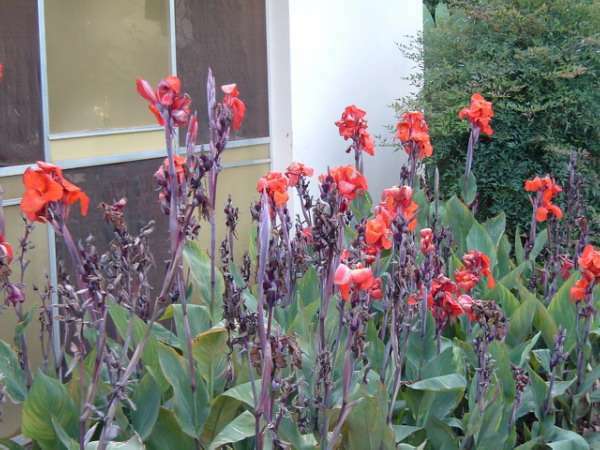
Denis Conrado, at Federal University of Lavras, Brazil. / CC BY-SA
It grows where there is little humidity, requiring moderate and well-distributed rainfall, between 500 and 1,200 mm.
It prefers loose soils, with a loamy or loamy-silty texture, rich in organic matter.
It tolerates acidity and grows well in soils with a pH of 4.5 to 8. Its cultivation adapts well to temperature ranges between 14-16 °C and 27-32 °C, depending on the cultivar.
✔ Main cultivars used in Colombia
Four cultivars are mainly planted in Colombia: foreign, red, natagueña and raizuela. The foreign variety has the largest and heaviest rhizomes (429 g of average weight per rhizome). In some countries, a production of 23 t/ha is reported after four months, and 85 t/ha after one year.
The sowing density of the plant ranges from 13,333 to 20,000 rhizomes per ha, at a distance of 1 to 0.5m, and from 1 to 0.75m.
The plant propagates by rhizomes. The harvest takes place between six and nine months after sowing, depending on the cultivar, the altitude, and the type of soil.
But the actual harvest time is variable and problematic because it constitutes a critical point for starch yield, and depends on the cultivar planted, the height above sea level of the plantation, and the prevailing climatic conditions.
Harvesting is done manually, with the help of a shovel or barretón, in small production units.
✔ Reasons why it is grown
The achira is commonly used as an ornamental plant in gardens.
In some cases, the plant is used to purify wastewater, and to serve as a barrier to the invasive advance of grasses such as kikuyu (Pennisetum clandestinum), spreading easily and quickly on the surfaces where it is placed.
The plant is cultivated especially for its spherical, cylindrical or top-shaped rhizomes, which are 5 to 25 cm long and 3 to 12 cm wide.
Achira is traditionally cultivated in small peasant production units and in family gardens, allocating them mainly for self-consumption, which may add up, in Colombia alone, to some 800 hectares.
But it is an item that has been progressively reduced to fewer and fewer cultivated areas, due to the lack of automated production and lack of demand for the product.
The custom of wrapping prepared meals or food with its leaves has been lost in the Andean countries to the extent that they urbanize. Achira is also cultivated in the central region of Ecuador, in the Pillaro canton in the province of Tungurahua, at 2,800 meters above sea level (Arcos-Jácome 2015).
✔ Cultivars
Caicedo (2000) points out that about ten cultivars have been identified.
Among them, those with the highest yield potential are Native (Altamira II), Green or Smooth (Caqueza C), Red (Pasto N), Morada de San Agustín (H), Raizuda (Caqueza C), Foreign (Caqueza C), and Pasture White (N).
The average biomass production is 21 t/ha at the time of harvest, that is, considering leaves, stems, corms and other plant parts.
Arcos-Jácome (2015) distinguishes four types of achira: red (Caqueza), purple (San Agustín, Los Pinos), white (Pasto, Maituna) and green (Verde or Lisa, Native).
✅ Nutritional value
The achira rhizome contains abundant water and carbohydrates, low levels of protein, and high doses of ascorbic acid, vitamin A, and minerals such as calcium, iron, potassium, and magnesium. Starch is extracted from the rhizome, which is a polysaccharide carbohydrate, constituting a food reserve for plants, and is made up of amylose and amylopectin. Achira starch is considered of excellent quality.
In 100 g of edible matter, mainly from its rhizome, there are 123 Kcal, 66.8 g of water, 1 g of protein, 31.3 g of carbohydrates and 0.5 g of fiber. It also contains some vitamins, such as ascorbic acid (7 mg), niacin (0.45 mg), thiamin (0.03) and riboflavin (0.01 mg), and some minerals: phosphorus (63 mg), calcium (15 mg) and iron (1.4 mg).
Espinosa, Vaca, Abad, Grissman (1996) present similar nutritional values per 100 g: energy value 130 calories, water 66.30 g, protein 0.90 g, fat 0.10 g, total carbohydrates 31.30 g, fiber 0.5 g, ascorbic acid 7 mg, phosphorus 63 mg, and calcium 15 mg.
The comparative nutritional analyzes of the white and purple achira varieties, carried out by Arcos-Jácome (2015), give the following results:
- Energy (Kcal): 101 white / 98 purple.
- Protein (g): 1.40 / 1.40.
- Total fat (g): 0.10 / 0.10.
- Carbohydrates (g): 23.80 / 23.80.
- Vitamins (mg): C: 0.70 /0.10.
- Minerals (mg): Calcium: 13 / 17; Iron: 0.70 / 1.40.
✅ Food and craft uses
The edible part of the plant is the rhizome or corm. It can be consumed raw, grated, or in salads. It can be roasted or fried, and cut into thin slices.
It is also processed to extract a starch that has great nutritional value, apart from its reputed medicinal properties (diuretic, healing, immune system booster and others). Some specialists point out that, even being boiled, the rhizome maintains its nutritional properties.
✔ How to prepare achira starch
To prepare starch, the rhizomes are grated and placed in water; the fibers are then decanted and the starch is dried.
This starch has the largest grains known, making them easy to separate, and are transparent when cooked.
The red vs the green
In the food industry, the red-flowered achira is more widely used, because it has a thicker root and is richer in some minerals such as calcium and iron. But the most appreciated variety is the white or yunga achira, which produces a comparatively higher quality starch and a greater number of rhizomes.
✔ Typical dishes with achira starch
🔥 In Colombia
Mainly in the Colombian departments of Cundinamarca and Huila, the starch is used to make achira biscuits, sago bread, various collations, cookies, cakes, and noodles.
Small “ralanderías” still operate in these departments, which are in charge of processing the rhizomes to extract the starch.
How is the achira cake prepared?
The achira cake is made with achira starch, fresh curd, egg yolks, salt and butter. First, make a dough with a mixture of all the ingredients. Then, let it rest, shape the biscuits, and bake in a buttered mold for 12 minutes at a temperature of 300 °C.
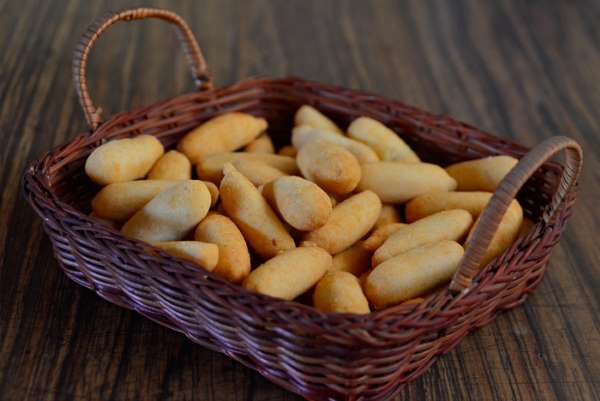
🔥 In Venezuela
In some Venezuelan regions the use of the achira rhizome is popular.
In the coastal region of the state of Sucre, on the Paria peninsula, an atol beverage is made for children, the elderly and convalescents, based on the belief of its great nutritional power and easy digestibility.
🔥 In Ecuador
In Ecuador, a colada is prepared for children after weaning, known as the Colada de Niño or Chuno. It is made with achira starch, panela honey, naranjilla, cinnamon and cloves.
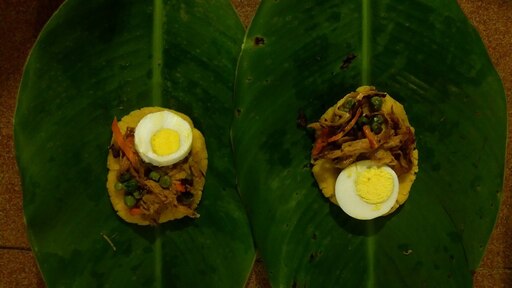
In some areas of Ecuador, such as the province of Azuay, a sweet starch bread known as achiras is made.
Achira is used in lojan quesadillas, in the province of Loja (Arcos-Jácome 2015).
Achira bread is prepared in the Pillaro canton, in the province of Tungurahua, with a mixture of achira starch, eggs, yeast, butter, cheese and lard, and cooked in a wood oven. In that province, achira starch is called chuno.
✔ Uses of achira leaves
Achira leaves are used as food wrap in the Amazon basin and in rural areas of many Latin American and Caribbean countries, particularly for tamales, buns, quimbolitos, hallacas (in the area of Pregonero, Táchira state, Venezuela ), and as fodder for animals.
According to Díaz Piedrahita (2012), the use of achira leaves is very widespread in Colombia for the purpose of wrapping different foods for commercialization, packing typical foods, and also as food, being well documented since the mid-eighteenth century.
✔ Figures that reveal a change in diets
Gonzáles-Benavides pointed out in 1987 that in Colombia achira was cultivated mainly in the departments of Cundinamarca in the east and in Huila in the south.
At that time, some 1,400 tons of achira starch were produced in Colombia per year thanks to the efforts of 1,169 small producers.
The greatest use of starch was as a raw material for the preparation of achira biscuits, produced by some 266 companies, of the artisanal bakery type, which generated some 2,537 permanent jobs.
These figures show that achira cultivation was deeply rooted in the regional economies and in the gastronomic customs of some departments of Colombia.
The changes mentioned, both in the production and consumption of achira starch and its by-products, are a clear manifestation of changes in diets in some regions of Colombia.
✔ Other uses of the rhizome and seeds
The rhizome is quite similar to the potato, and is prepared and eaten in a similar way, but it is harder and takes longer to cook than the potato. The rhizome and other parts of the plant are used for human consumption and as animal fodder (particularly stems and leaves), and for agribusiness (specialized in the production of starch, for baking and to thicken soups).
The seeds — small, spherical, hard and black — are used by artisans to make necklaces, bracelets, and rattles, or maracas.
✅ Medicinal properties
Various parts of the plant are used for medicinal purposes: the rhizome, the leaves, and even the seeds.
- To cure mastitis, a piece of achira stem is wrapped in banana leaves and seared. Still warm, the juice is squeezed over the affected area.
- To relieve dry cough, a teaspoon of the juice squeezed from fresh stems is ingested.
- To calm headaches, the leaves are crushed and placed on the head.
- To cure rheumatism, it is recommended to boil the achira leaves and place them as a poultice on the affected areas.
- To heal skin ulcers, the leaves are boiled with enough water to wash the affected area with the resulting liquid.
- As an antigorroneic and diuretic, the water from the cooking of the leaves and the root of achira is ingested.
- The juice of the leaves is used as an antiseptic and healing agent — the leaves being placed on burned areas to calm and refresh.
- The seeds are used to relieve stomach problems. In this case, the dosage is one teaspoon of seeds per cup of boiling water.
Bibliography
- Arcos-Jácome RX (2015). Achira starch research. Gastronomic proposal for the Pillaro canton. Thesis. Quito. Equator Technological University. PDF
- Caicedo G. (2014). The cultivation of achira : alternatives for the small producer. Andean roots. Contribution to knowledge and training. Achira (Canna edulis). 11, Colombian Corporation for Agricultural Research (CORPOICA). PDF
- Diaz Piedrahita S. (2012). The leaves of plants as food wrap. Bogota: Ministry of Culture. Basic Library of Traditional Kitchens of Colombia. PDF
- Espinosa P., Vaca R., Abad J., Grissman C. (1996). Andean roots and tubers. Marginal crops in Ecuador. Current situation and limitations for production. Quito: Abya Yala. PDF
- Gonzales-Benavides CE (1987. Agronomic study of the Achira (Canna edulis), in Nariño, Pasto. Technological Research Institute. PDF
- Idrovo-Vallejo WA (2010). Feasibility study for the production and commercialization of achira flour (Canna edulis) in the Loja canton. Thesis. Quito. National polytechnic school. PDF
- Maas van de Kamer H., Maas PJM (2008). The Cannacea of the world. BLUMEA , 53 (2), 247-318. PDF

Dr. Rafael Cartay is a Venezuelan economist, historian, and writer best known for his extensive work in gastronomy, and has received the National Nutrition Award, Gourmand World Cookbook Award, Best Kitchen Dictionary, and The Great Gold Fork. He began his research on the Amazon in 2014 and lived in Iquitos during 2015, where he wrote The Peruvian Amazon Table (2016), the Dictionary of Food and Cuisine of the Amazon Basin (2020), and the online portal delAmazonas.com, of which he is co-founder and main writer. Books by Rafael Cartay can be found on Amazon.com
This post is also available in:
![]() Español (Spanish)
Español (Spanish)

